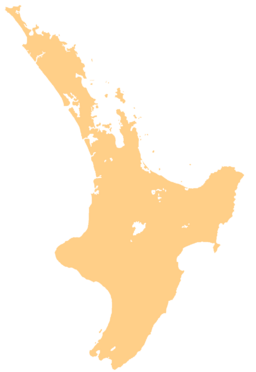Lake Ōkareka facts for kids
Quick facts for kids Lake Ōkareka |
|
|---|---|
 |
|
| Location | Rotorua Lakes, Bay of Plenty Region, North Island |
| Coordinates | 38°10′S 176°22′E / 38.167°S 176.367°E |
| Type | Crater Lake |
| Primary outflows | Waitangi Springs |
| Catchment area | 19.8 km2 (7.6 sq mi) |
| Basin countries | New Zealand |
| Max. length | 2.8 km (1.7 mi) |
| Max. width | 1.9 km (1.2 mi) |
| Surface area | 3.4 km2 (1.3 sq mi) |
| Average depth | 20.0 m (65.6 ft) |
| Max. depth | 34 m (112 ft) |
| Surface elevation | 355 m (1,165 ft) |
| Settlements | Lake Okareka |
Lake Ōkareka is a beautiful lake in New Zealand's North Island. It's one of four smaller lakes located between Lake Rotorua and Lake Tarawera. You can find it in the Bay of Plenty region. The other lakes nearby are Lake Rotokakahi (also known as Green Lake), Lake Tikitapu (Blue Lake), and Lake Okataina. All these lakes are part of a large volcanic area called the Okataina caldera.
Contents
Lake Ōkareka's Location and Features
Lake Ōkareka is about 6 miles (10 km) around. It sits about 60 meters (197 feet) higher than Lake Tarawera. The lake's water flows out underground for about half a mile (0.8 km). This underground flow then creates the Waitangi waterfall. It seems that Lake Ōkareka might even be connected to Lake Tarawera by hidden underground channels.
Exploring Lake Ōkareka's Past
This quiet lake is a charming place. It is surrounded by hills that are mostly covered in thick forests. While it's close to the main tourist road between Rotorua and Tarawera, it's hidden from view. A side road lets you get to the lake. People who enjoy fishing find it a great spot. For a long time, the lake's peacefulness was mostly undisturbed.
Many years ago, a settler built a house on a low piece of land. This land connected an island-like hill in the lake to the mainland. Some parts of the lakefront are still privately owned. However, most of the land around the lake is now used for homes.
The Meaning Behind the Name
The name Ōkareka means "the lake of sweet food." Long ago, the Māori people grew sweet potatoes, called kumara, around the lake. The lake was first written about by Sir George Grey. It was also mentioned in a poem by Alfred Domett called "Ranolf and Amohia."
Early Visits and Discoveries
Sir George Grey visited Lake Ōkareka during his travels in the Lakes Country. This trip happened in the summer of 1849-1850. His journey was described in a rare book. It was written by his secretary, G. S. Cooper, in 1851. In those days, the path from Ohinemutu to Tarawera went along the shore of Lake Ōkareka. It then reached the larger lake near a mission station called Kariri.
On December 27, 1849, Governor Grey and his group walked from Rotorua to Tarawera. It was a very hot day. The journal entry from that day describes reaching Lake Ōkareka. It mentions a spring of wonderfully cool water where they refreshed themselves. Then, they crossed the lake in canoes. The journal says the lake was "extremely pretty." Its shores were high and wooded, except for valleys at each end. A peninsula with a pa (a Māori village or fort) called Taumaihi jutted into the middle of the lake. The water was very clear and deep.
The journal also noted that the lake had no clear outlet. Its water flowed through an underground stream. This stream was hidden for about half a mile. Then, it reappeared like a fountain, gushing through rocks. From there, it flowed as a small stream to Lake Tarawera. Lake Tarawera is about 60 feet (18 meters) lower than Lake Ōkareka. The water falls 20 feet (6 meters) into Lake Tarawera. This creates a beautiful waterfall surrounded by karaka and other evergreen trees.
Māori Life and Nature
In those times, the shores of Ōkareka were full of Māori life. There were farms near the water. The local people fished for whitebait, koura (a type of crayfish), and a small fish called toitoi. These fish were plentiful before trout were brought to the area by European settlers. In the 1860s, Alfred Domett also visited Ōkareka and Tarawera using the same path Grey took.
The forest around Lake Ōkareka stretches to the western side of Lake Okataina. It also reaches the Whakapoungakau Range. Red deer live in the bush. While they are popular for hunting in Rotorua, they can harm the forest.
Today, about 600 people live near Lake Ōkareka. The lake is known for its natural beauty. It is easily reached from the popular tourist town of Rotorua.
Protecting Lake Ōkareka's Water Quality
Lake Ōkareka has water that is usually clear and clean. People use the lake a lot for fun activities. These include boating, swimming, and fishing. However, the water quality has been getting worse in recent years. This is because of too much nitrogen and phosphorus. These nutrients come from nearby farmland, home septic tanks, and from nutrients already in the lake bed.
To help the lake, the Lake Ōkareka Catchment Management Plan was created in 2004. This is a long-term plan to make the water cleaner. It includes things like updating sewage reticulation systems. It also involves treating the lake water with chemicals and managing farm nutrients. Experts have calculated how much nutrients need to be reduced. The goal is to lower nitrogen by 2.5 tonnes per year. Phosphorus needs to be lowered by 0.08 tonnes per year.
The Trophic Level Index (TLI) shows how healthy a lake is. It uses different measurements and is an average over three years. A lower TLI means better water quality. For Lake Ōkareka, the TLI has not changed much in the last five years.



